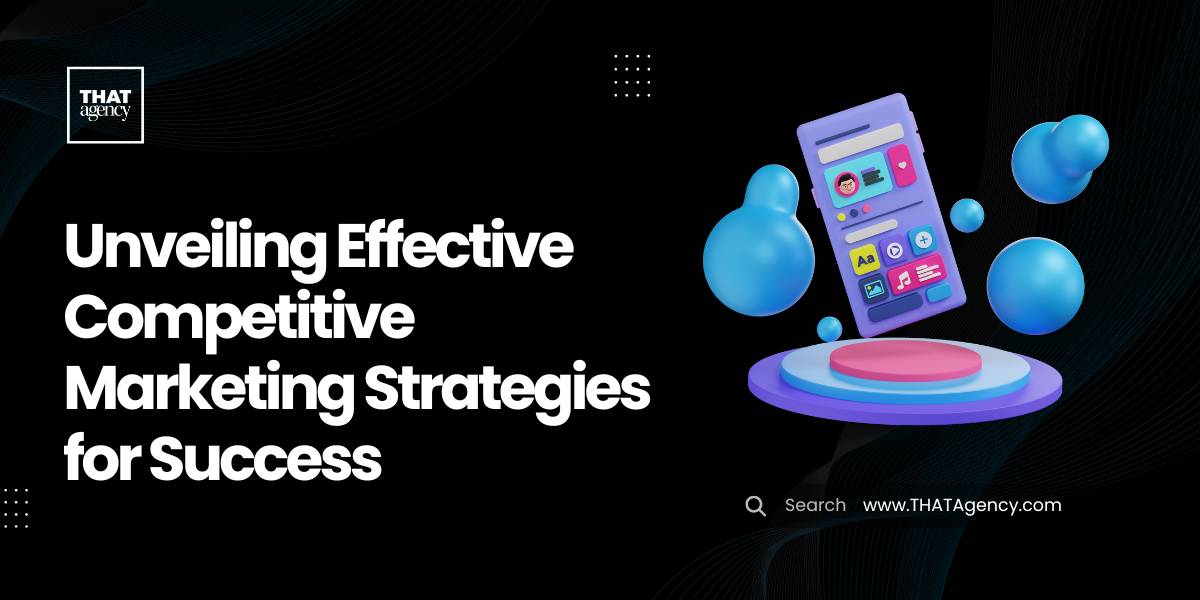In the dynamic battlefield of business, victory belongs to those who master the art of competitive marketing. This comprehensive guide will illuminate the path to success through competitive marketing strategies, offering valuable competitive insight that empowers businesses of all sizes to not only survive but thrive in today’s cutthroat market.

Introduction to Competitive Marketing Strategies: A Deep Dive
Competitive marketing strategies are the heart of a business's success in the fiercely competitive global marketplace. These strategies are not about engaging in a price war or mimicking what others are doing. Instead, they're about a thoughtful analysis of the competitive landscape—identifying your competitors' strengths and weaknesses and understanding your unique value proposition (UVP). This is where the art and science of marketing converge to craft a distinct space for your brand, a niche where you are seen as the best choice by your target audience.
The Anatomy of Competitive Marketing Strategies
- Competitive Analysis: This foundational step involves gathering intelligence about your competitors. What products or services do they offer? What pricing strategy do they use? How do they market themselves? This information lays the groundwork for identifying opportunities where your business can excel.
- Understanding Your Unique Value Proposition: Your UVP is what makes your business stand out from the crowd. It's the reason customers should choose you over your competitors. Defining your UVP requires a deep understanding of your target audience's needs, desires, and pain points, and how your products or services uniquely address these.
- Strategic Positioning: Once you've identified your UVP, the next step is to communicate it effectively. This involves positioning your brand in such a way that it resonates with your target audience, highlighting the benefits and solutions you offer that competitors do not.
- Adaptive Strategy Development: The competitive landscape is always changing. New competitors emerge, technologies evolve, and customer preferences shift. Successful competitive marketing strategies are flexible and adaptive, allowing your business to respond to changes quickly and efficiently.
Gaining Competitive Insight: Beyond the Basics
Competitive insight goes deeper than merely listing who your competitors are. It's an ongoing process of understanding their strategies, predicting their next moves, and preparing to counteract them effectively. This proactive approach involves several key activities:
- Marketing Tactics Analysis: Examining the channels, content, and messaging your competitors use can reveal what works (or doesn't) in your industry. This insight helps in refining your marketing tactics to be more effective.
- Sales Process Scrutiny: By understanding how your competitors move a prospect from awareness to decision, you can identify gaps or strengths in your own sales process.
- Customer Feedback Mining: What are customers saying about your competitors? Reviews, social media comments, and customer testimonials can provide critical insights into what customers value or dislike, helping you to adjust your offerings accordingly.
Tailoring Strategies for Diverse Businesses
Competitive marketing strategies are not one-size-fits-all. They must be customized to fit the unique needs and goals of each business, whether it's a small local shop looking to boost online visibility or a large e-commerce platform requiring sophisticated web development and advertising strategies. This tailored approach is especially critical for:
- B2B and B2C Clients: Both segments have distinct needs and decision-making processes. Your competitive strategy should address these differences head-on, providing clear, tailored solutions that speak directly to each group's unique challenges and opportunities.
- Startups: New businesses need to make a big splash to capture attention in a crowded market. Competitive strategies for startups often focus on innovation, leveraging new technologies or approaches to disrupt traditional markets.
- Established Businesses: For these companies, competitive strategies might focus on sustaining growth, exploring new markets, or defending market share against rising competitors. The emphasis is on leveraging brand strength, customer loyalty, and deep market knowledge to maintain a competitive edge.
Crafting and implementing effective competitive marketing strategies require a blend of analytical insight, creative thinking, and a deep understanding of both your own business and the competitive landscape. By focusing on these areas, businesses can create a sustainable competitive advantage that drives growth and success in any market condition.
The Pillars of Competitive Marketing Success
Competitive marketing success is built upon several key pillars that together form a robust foundation for outperforming competitors and captivating your target audience. Here’s a closer look at these essential components:
Market Research: The Bedrock of Strategy
Market research is fundamental to understanding the terrain in which your business operates. It encompasses the collection and analysis of data regarding your industry's landscape, current trends, and customer expectations. This process involves:
- Trend Analysis: Keeping an eye on industry trends to predict future market directions and customer preferences.
- Customer Segmentation: Identifying distinct groups within your target market to tailor marketing efforts more effectively.
- Competitive Landscape Mapping: Understanding the positioning, strengths, and weaknesses of competitors within your market.
Comprehensive market research provides the insights needed to make informed strategic decisions, ensuring your marketing efforts are aligned with market realities and opportunities.
Competitor Analysis: Learning from the Competition
Competitor analysis is a critical exercise that helps you understand your rivals’ strategies, their successes, and where they fall short. It involves:
- Benchmarking: Comparing your products, services, and marketing strategies against those of your competitors.
- SWOT Analysis: Identifying your competitors' Strengths, Weaknesses, Opportunities, and Threats.
- Strategy Reverse Engineering: Understanding the underlying tactics and strategies your competitors use to attract and retain customers.
This analysis not only highlights areas where you can improve but also helps identify opportunities to differentiate your brand.

Unique Selling Proposition (USP): Differentiating Your Brand
Your USP is what sets your business apart from the competition. It’s a clear statement that describes the unique benefit your product or service provides, how it solves your customers' problems, and what distinguishes your offer from competitors. Effective USPs are:
- Customer-focused: Centered on a benefit that is highly valued by your target market.
- Clear and Concise: Easily understood and memorable.
- Genuine: Reflective of the true experience customers can expect
Defining and communicating your USP is crucial for guiding your marketing messages and strategies.
Customer-Centric Marketing: The Heart of Your Strategy
Putting customers at the center of your marketing strategy involves understanding and addressing their specific needs, desires, and pain points more effectively than your competitors. This approach requires:
- Personalization: Tailoring your marketing messages and offers to meet the individual needs of different customer segments.
- Customer Journey Mapping: Understanding the path your customers take from awareness to purchase and beyond, to optimize touchpoints along the way.
- Problem-Solving: Positioning your products or services as solutions to your customers' problems.
A customer-centric approach ensures that your marketing efforts resonate deeply with your target audience, fostering loyalty and advocacy.
Digital Presence and SEO: Your Online Foundation
In the digital era, a strong online presence and strategic SEO are vital for making your brand discoverable to potential customers. Key aspects include:
- Website Optimization: Ensuring your website is user-friendly, mobile-responsive, and optimized for search engines.
- Keyword Strategy: Incorporating relevant keywords into your website content to improve search rankings.
- Local SEO: Optimizing your online presence for local search results, is crucial for businesses serving specific geographic areas.
An effective digital presence and SEO strategy increase your visibility online, driving traffic and engagement.
Content Marketing: Engaging Your Audience
Content marketing involves creating and sharing valuable, relevant content to attract and engage a clearly defined audience. This strategy is designed to:
- Establish Authority: Position your brand as a thought leader in your industry.
- Drive Engagement: Encourage interaction and sharing through high-quality content.
- Support SEO Efforts: Improve your search engine ranking through keyword-rich, valuable content.
Successful content marketing not only attracts potential customers but also retains them by creating brand loyalty.
Social Media Strategy: Connecting with Your Audience
Social media provides an unparalleled platform to connect with your audience, offering:
- Brand Visibility: Enhancing your brand's presence and reach.
- Customer Engagement: Fostering direct communication and interaction with your audience.
- Market Insights: Gleaning valuable feedback and trends from social media behavior.
A well-crafted social media strategy can significantly boost your brand's visibility and loyalty.
Feedback and Adaptation: The Cycle of Improvement
Continuous feedback from your customers provides invaluable insights into their needs and perceptions. Regularly soliciting and acting on feedback allows you to:
- Refine Products/Services: Make adjustments based on direct customer input.
- Adapt Strategies: Evolve your marketing strategies in response to market changes and customer feedback.
- Foster Customer Relationships: Show your customers that their opinions are valued and considered.
Embracing feedback and being willing to adapt your strategies are key to staying relevant and competitive.
Crafting Your Path to Success
Implementing effective competitive marketing strategies is a multifaceted endeavor that demands diligence, creativity, and a relentless focus on delivering unparalleled value to your customers. By mastering these pillars of competitive marketing success and continually seeking deep competitive insight, you position your business to outthink and outmaneuver competitors. Remember, the ultimate goal is not merely to spend more but to think smarter and act more strategically, ensuring your business's growth and sustainability in the ever-evolving marketplace.
Crafting Your Competitive Edge with THAT Agency
As you journey through the maze of competitive marketing strategies, it's clear that having a trusted partner can significantly amplify your success. THAT Agency stands as your ideal ally in this quest, offering comprehensive digital solutions tailored to propel your business to the forefront of its industry.
Whether you're seeking to enhance your online presence, optimize your website for better engagement and conversion, or unleash the full potential of targeted advertising and SEO, THAT Agency has the expertise and experience to guide you every step of the way. Our deep understanding of competitive insight equips them to craft bespoke strategies that align perfectly with your business goals, ensuring you not only meet but exceed your expectations.
Unlock Your Competitive Edge
Ready to outpace the competition? Grab your free copy of our Competitive Analysis Framework today. It's packed with insights and strategies to help you understand your market better and position your business for success. Don't miss out—download now and start shaping your competitive edge!





